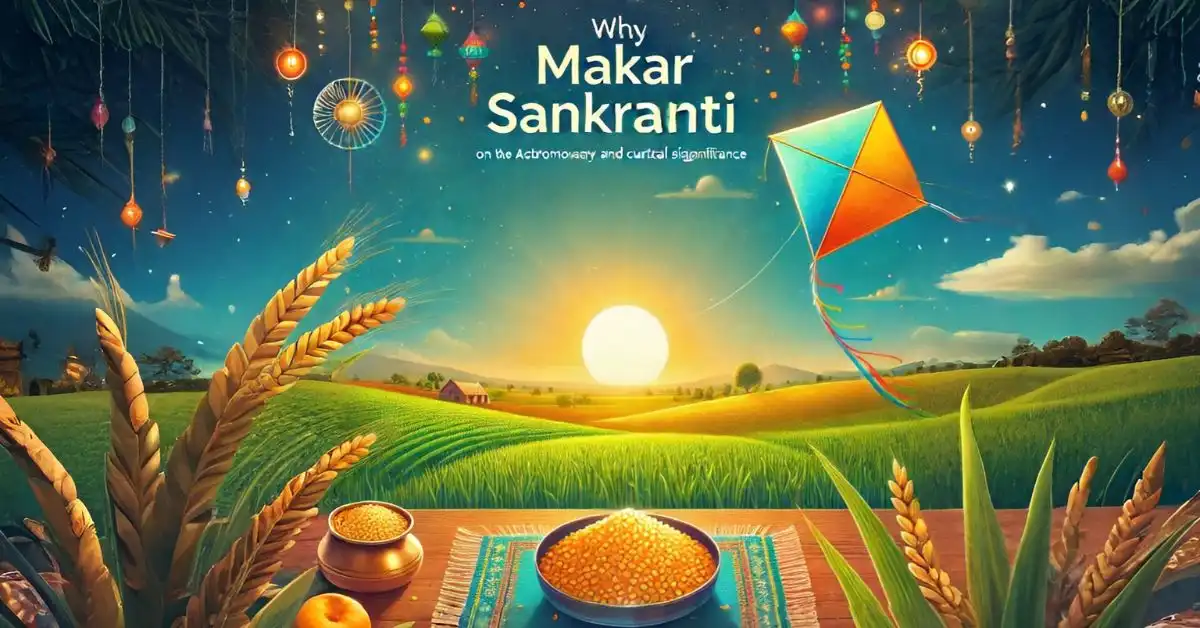Why Makar Sankranti is Celebrated on 14th January: The Astronomical and Cultural Significance

Jan 09, 2025 291 views

What is Makar Sankranti?
Makar Sankranti is a Hindu festival that celebrates the Sun’s movement into the zodiac sign of Capricorn, also known as Makara in Sanskrit. The word "Sankranti" means transition. This day marks the end of the winter solstice and the beginning of longer days, signaling the arrival of spring. It is one of the few Hindu festivals based on the solar calendar, which is why it falls on the same date every year.
The Astronomical Significance
The Sun’s Transition into Capricorn
On Makar Sankranti, the Sun moves from the zodiac sign Sagittarius (Dhanu Rashi) to Capricorn (Makara Rashi). This is a major celestial event because it marks the Sun’s northward journey, called Uttarayan. In Hindu tradition, Uttarayan is considered an auspicious time when good deeds and ceremonies bring greater benefits.
The Importance of January 14th
You might wonder why Makar Sankranti is celebrated on January 14th and not on other dates. The Earth’s revolution around the Sun causes slight changes in the solar calendar. While the date of Makar Sankranti might shift slightly over long periods, it remains consistent in the modern era because of accurate astronomical calculations.
During this time, the Sun aligns with the Tropic of Capricorn. This alignment is significant as it represents the end of the darkest days and the start of brighter, longer days. Ancient Indian astronomers used this alignment to mark the beginning of a new agricultural cycle.
The Cultural Significance
Harvest Festival
Makar Sankranti is primarily a harvest festival. It is celebrated to thank the Sun and nature for a bountiful harvest. Crops like rice, sugarcane, and sesame seeds are harvested during this time, making it a time of joy and abundance for farmers.
Different Names Across India
Makar Sankranti is celebrated under different names in various parts of India, but the spirit of the festival remains the same:
Pongal in Tamil Nadu: A four-day festival where people boil new rice in milk to thank nature.
Uttarayan in Gujarat: Famous for its kite-flying tradition.
Magh Bihu in Assam: Marked by bonfires and community feasts.
Lohri in Punjab: Celebrated with dancing and singing around a bonfire.
Rituals and Traditions
Kite Flying
One of the most popular activities during Makar Sankranti is kite flying, especially in states like Gujarat and Rajasthan. People fill the skies with colorful kites, symbolizing the freedom and joy that come with longer days.
Holy Dips
On this day, many people take a dip in holy rivers like the Ganga, Yamuna, or Godavari. It is believed that bathing in these rivers washes away sins and brings spiritual blessings. Places like Prayagraj and Haridwar witness huge gatherings of devotees.
Delicious Food
Food is an essential part of Makar Sankranti. Special dishes made of til (sesame seeds) and jaggery are prepared. These ingredients are not only delicious but also provide warmth and energy during the cold winter months.
Tilgul: Sweet balls made of sesame and jaggery, popular in Maharashtra.
Pongal: A rice and milk dish cooked in Tamil Nadu.
Chikki: A crunchy sweet made with peanuts and jaggery.
Bonfires and Dancing
In regions like Punjab and Haryana, people celebrate the evening of Makar Sankranti with bonfires. Families gather around the fire, sing traditional songs, and perform dances like Bhangra and Gidda.
Symbolism of Makar Sankranti
Makar Sankranti is not just a festival but also a reminder of the importance of balance and gratitude. The Sun’s northward journey symbolizes enlightenment and spiritual growth. It encourages people to leave behind the darkness of the past and embrace the light of new opportunities.
In Hindu mythology, Makar Sankranti is also significant because it is the day when Bhishma Pitamah from the Mahabharata chose to leave his mortal body during the auspicious period of Uttarayan.
Global Influence
While Makar Sankranti is deeply rooted in Indian culture, its themes of renewal, gratitude, and joy resonate with people worldwide. Many countries celebrate similar festivals during the harvest season, such as Thanksgiving in the United States and the Chinese New Year.
Conclusion
Makar Sankranti is a beautiful blend of astronomy, culture, and spirituality. Celebrated on January 14th each year, it marks the Sun’s transition into Capricorn and the arrival of longer, brighter days. With its rich traditions of kite flying, delicious food, and community gatherings, this festival brings people together in gratitude and hope for the future. Next time you celebrate Makar Sankranti, take a moment to appreciate the science and significance behind this joyous day.